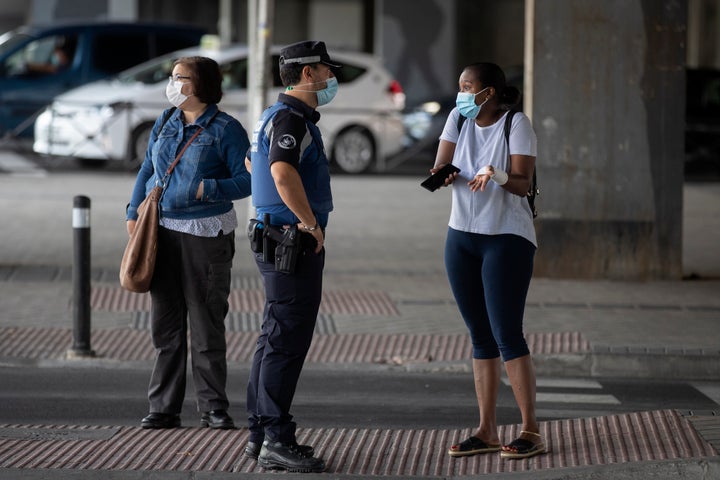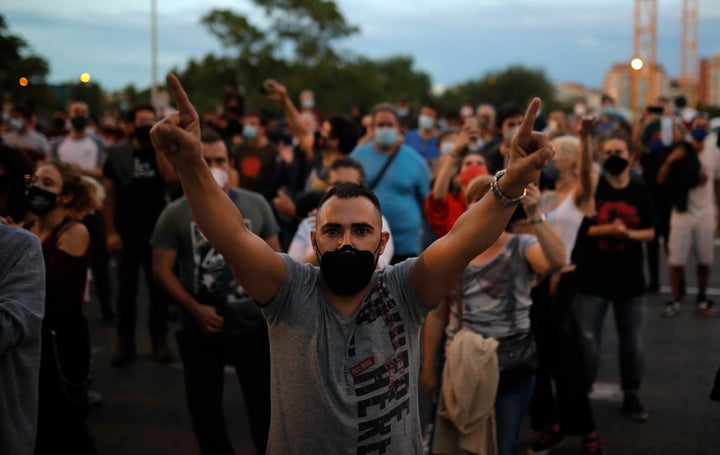The applause on balconies all over Spain ― in solidarity with health care workers ― that thundered through the country’s streets between March and May has turned in recent days to anger and protest from Madrid’s poorest communities. Spain is living its own autumn of discontent, while Madrid is facing an autumn of inequality.
In terms of COVID-19 contagion and the number of victims, the capital of Spain has been the worst hit in Europe. This critical situation has led the president of the Community of Madrid, conservative Isabel Díaz Ayuso, to decree a partial lockdown of the city for at least two weeks.
The measures, which prevent movement except in cases of basic need — for example, commuting to work or taking children to school — affect 37 health districts of the city. Coincidentally, these health districts are some of the neighborhoods or municipalities with the lowest incomes in all of Madrid. In total, it will affect 885,000 citizens, 13% of Madrid’s population.
This isn’t just a health care issue. The fact that affluent neighborhoods can carry on as normal, while those with fewer resources now have additional problems to add to their already difficult lives, has reopened the debate on discrimination throughout Spain and shown that the virus affects not individuals but social classes.

Many families in these neighborhoods live in precarious situations, whether in substandard housing or crowded into tiny apartments. The streets are generally very narrow, services are poorly maintained, and public transportation is usually full. The perfect conditions, in short, for the virus to spread. Plus, many of the inhabitants work in the service sector, the hotel industry, or clean houses in more affluent neighborhoods, while they may also care for dependents.
“The spread of infection is occurring, among other things, because of the way of life that our immigrants have in Madrid,” Díaz Ayuso said last week. Her words generated such an uproar that, a few minutes later, she had to clarify that she was neither racist nor classist, but merely pointing out a reality.
“It is part of our political responsibility not to launch xenophobic messages that stigmatize migrants, especially in these sensitive times,” complained the nonprofit Spanish Commission for Refugee Aid. “Words like these pose a danger to the coexistence that they must build.”
The fact is that the accumulated incidence of COVID-19 in some of the poorest neighborhoods in Madrid — all of which are located in the south, with a substantial immigrant population — such as Carabanchel, Usera, Villaverde or Puente de Vallecas, is far higher than that recorded in wealthier districts, such as Retiro or Moncloa-Aravaca, in the north of the city.
Carabanchel, a poor district, recorded 884.24 cases per 100,000 inhabitants, as of mid-September; Usera, 1,155.71; Villaverde, 1,157.47; Puente de Vallecas, 1,240.76. In Retiro and Moncloa-Aravaca, located further north, the accumulated incidence has not reached 500 cases per 100,000 inhabitants.

A few hours before the selective lockdown came into effect in Madrid, residents of the affected areas took to the streets to protest the conservative president’s “discriminatory” measures that “segregate” the population. “Fascist Ayuso, you are classist” or “It’s not confinement, it’s segregation,” were some of the protesters’ slogans.
The massive protest organized last Sunday by unions, leftist parties, and neighborhood associations in Madrid against Díaz Ayuso’s “useless and clearly segregationist” measures was just a teaser. The demonstrators are also urgently calling for an increase in the number of coronavirus tracers, the number of personnel in laboratories, and the materials necessary to reduce the waiting times for basic COVID-19 test results. Furthermore, they are demanding that the number of primary care workers not be reduced in the next few years, as well as that a scientific committee be created to “steer and control” all decisions regarding the pandemic.
They are locking us up like they walled off the areas affected by the Black Death.
Historian Rubén Fernández-Avilés
“With the measures that have been announced, they are taking our neighborhoods back to the 14th century. They are locking us up like they walled off the areas affected by the Black Death. The workers cannot leave their neighborhoods except to travel like cattle on the metro, to produce and keep business moving, so that they can continue to make money. But only for that. The police and even the army, if necessary, will make sure that we do not leave the perimeter for anything else. In reality, more than the 14th century, it looks like a recent futuristic series,” historian Rubén Fernández-Avilés told HuffPost Spain.
While anger grows in the poor neighborhoods of the south, the inhabitants of the rich areas in the north watch the increasing rate of coronavirus in Madrid with concern, dismissing the protests from the lower classes. In fact, the population of the wealthier neighborhoods took to the streets in a state of alarm, criticizing Spain’s socialist government for restricting their freedom by confining the entire population.
The banging of pots and pans can no longer be heard in Madrid, but the cries of the working class are growing louder by the day.
A HuffPost Guide To Coronavirus
Everyone deserves accurate information about COVID-19. Support journalism without a paywall — and keep it free for everyone — by becoming a HuffPost member today.
Calling all HuffPost superfans!
Sign up for membership to become a founding member and help shape HuffPost’s next chapter
Credit: Source link